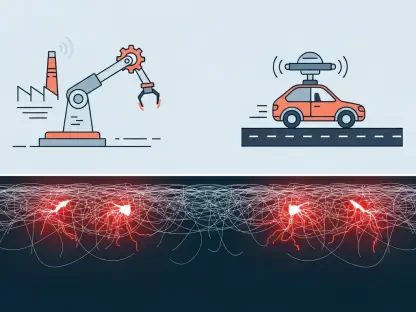In the rapidly shifting landscape of fiber network development, a fierce legal confrontation has emerged between Tilson Technology Management, a contractor specializing in network construction, and Gigapower, a collaborative venture between AT&T and BlackRock aimed at expanding high-speed internet infrastructure. This dispute, rooted in a staggering $600 million contract to build fiber networks across Nevada and Arizona, has devolved into a series of lawsuits, crippling financial losses, and a bankruptcy filing that underscores the fragility of such high-stakes partnerships. What began as a potentially transformative collaboration has morphed into a stark warning about the perils of contractual disagreements in the telecommunications industry. The fallout has not only affected the immediate parties involved but also casts a shadow over how similar deals might unfold in this competitive sector, where the demand for robust internet connectivity continues to surge.
The unraveling of this partnership has placed Tilson in a precarious position, with the company filing for Chapter 11 bankruptcy protection earlier this year after alleging severe financial misconduct by Gigapower. Claims of delayed payments and forced renegotiations have painted a troubling picture of imbalance, where smaller entities struggle under the weight of larger corporate maneuvers. Meanwhile, Gigapower remains steadfast, pursuing its expansive goals despite the legal entanglements. This clash offers a glimpse into the broader challenges facing the industry as it races to meet growing connectivity needs.
Contractual Disputes and Financial Strain
Breach Allegations and Bankruptcy
The core of Tilson Technology Management’s grievances lies in accusations that Gigapower deliberately withheld payments, creating a financial stranglehold that led to dire consequences for the contractor. Tilson asserts that over $200 million is owed, including substantial termination charges for costs that cannot be recouped, such as equipment and subcontractor fees. According to Tilson, these alleged delays in compensation were not mere oversights but strategic moves to pressure the company into accepting revised contract terms that slashed rates and reduced the scope of work. The resulting cash crunch forced Tilson to lay off hundreds of employees, disrupting lives and operations while pushing the company to the brink of collapse. This financial distress culminated in a Chapter 11 bankruptcy filing in May, a desperate bid to reorganize and survive the fallout of what was once heralded as the contractor’s largest-ever deal.
Beyond the immediate monetary disputes, Tilson’s situation highlights a deeper issue of trust and reliability in business agreements within the fiber network space. The contractor claims that Gigapower’s actions were not just breaches of contract but a calculated effort to exploit Tilson’s dependency on the project for its revenue stream. With hundreds of jobs lost and a reputation on the line, the bankruptcy filing became a public symbol of the severe toll such disputes can take on smaller players in the industry. Tilson’s legal filings in Texas further argue that the withheld funds represent not only a financial loss but also a betrayal of good faith, setting the stage for a courtroom battle that could redefine how payment terms are enforced in similar partnerships. The ripple effects of this crisis continue to challenge Tilson’s ability to regain footing in a competitive market.
Termination Fallout
Gigapower’s decision to terminate a significant portion of Tilson’s contract under a “termination for convenience” clause has become a pivotal point of contention in this legal saga. Executed on March 24, this move allowed Gigapower to end the agreement without specifying a cause, a provision often embedded in contracts to provide flexibility to larger entities. For Tilson, however, this termination was catastrophic, stripping away the foundation of their largest contract and leaving them scrambling to cover unrecoverable expenses. The contractor argues that this action was not merely a business decision but a devastating blow that directly contributed to their financial ruin, as the sudden loss of revenue made it impossible to sustain ongoing operations or meet existing obligations.
The impact of this termination extends beyond immediate financial losses, casting doubt on Tilson’s long-term viability as a player in the fiber network construction arena. The company contends that Gigapower leveraged the clause to seek cheaper subcontractors, a move that prioritizes cost savings over partnership stability. This perspective paints a grim picture of an industry where smaller firms can be discarded at will, regardless of prior commitments or performance. Tilson’s legal team has emphasized that the termination charges, estimated at $140 million, are critical to recovering from the setback, yet Gigapower’s refusal to pay has only deepened the wound. This episode serves as a stark reminder of the vulnerabilities inherent in contracts with such clauses, especially for companies heavily reliant on a single client.
Legal Battles and Material Conflicts
Materials Dispute in Arizona
Amid the broader contractual conflict, a separate legal skirmish emerged in Arizona over materials and equipment valued at approximately $3.6 million, further intensifying the rift between Tilson and Gigapower. Gigapower accused Tilson of holding these critical assets hostage, refusing access unless substantial payments were made to settle outstanding debts. This standoff, according to Gigapower, resulted in significant delays to network construction, with daily losses estimated at 10,000 feet of fiber deployment and over $200,000 in economic damage. Seeking swift resolution, Gigapower pursued legal action in an Arizona court, which initially ruled in their favor, granting immediate possession of the materials to mitigate further disruption to their expansion efforts. This ruling marked a temporary victory for the joint venture in a saga already fraught with tension.
However, the materials dispute took a complex turn with Tilson’s bankruptcy filing, which temporarily stayed the Arizona case and halted immediate enforcement of the court’s decision. Despite this pause, Gigapower eventually regained access to the property, resolving this specific issue while the larger conflict persisted. Tilson’s stance during this episode was that retaining the materials was a necessary leverage point to compel payment for services rendered, a position that underscores the desperation felt by the contractor amid mounting financial pressures. The resolution of this matter, though a win for Gigapower, did little to mend the fractured relationship between the two entities. Instead, it highlighted how secondary disputes can exacerbate primary conflicts, drawing attention to the logistical and legal intricacies that often accompany high-value infrastructure projects.
Courtroom Clashes and Ongoing Tensions
The legal battles between Tilson and Gigapower have not been confined to a single issue or jurisdiction, with multiple fronts opening up as each side seeks to protect its interests. Tilson’s primary lawsuit, filed in Texas, demands over $200 million in damages for what it describes as a clear breach of contract by Gigapower, focusing on unpaid fees and the fallout from the abrupt termination. This case represents a critical effort by Tilson to recover financially and hold Gigapower accountable for actions that allegedly led to bankruptcy. The contractor’s legal arguments center on the premise that Gigapower’s payment delays and coercive renegotiation tactics were not only unethical but also directly responsible for the company’s operational collapse, setting a precedent for how such disputes might be viewed in court.
On the flip side, Gigapower has mounted a vigorous defense, denying any breach and asserting that their actions, including the termination and pursuit of materials, were within contractual rights. The joint venture’s legal strategy appears to prioritize minimizing liability while maintaining focus on their broader fiber expansion goals. The ongoing courtroom clashes reflect a deeper inability to resolve differences outside legal channels, with both parties entrenched in their positions. This persistent tension suggests that the resolution of these disputes will likely be protracted, potentially influencing how future contracts in the telecommunications sector are drafted to avoid similar escalations. The stakes remain high as the industry watches closely, aware that the outcomes could shape partnership dynamics for years to come.
Business Impacts and Industry Implications
Tilson’s Operational Crisis
The financial and operational toll on Tilson Technology Management following the contract fallout with Gigapower has been nothing short of devastating, revealing the fragility of smaller contractors in large-scale deals. The company reported a staggering $91 million deficit tied directly to the project, a figure that encapsulates unrecovered costs and lost revenue after the termination. This deficit has forced drastic cutbacks, with hundreds of employees laid off and core operations scaled back to a fraction of their former capacity. Tilson’s reliance on Gigapower as its largest client amplified the impact, turning what should have been a growth opportunity into a survival struggle. The bankruptcy filing, while offering a chance to reorganize, casts a long shadow over Tilson’s future prospects in an industry that demands financial stability and reliability from its players.
Beyond the numbers, the human cost of Tilson’s crisis cannot be overlooked, as the layoffs have disrupted livelihoods and communities dependent on the contractor’s success. The company’s inability to absorb the financial shock highlights a critical vulnerability for smaller firms that stake their growth on partnerships with industry giants. Legal efforts to recover owed funds continue, but the damage to Tilson’s reputation and operational capacity may prove harder to mend. Industry observers note that Tilson’s plight could deter other small contractors from engaging in similar high-risk contracts without stronger safeguards. This situation serves as a cautionary example of how quickly fortunes can change when financial dependencies are not balanced with robust contractual protections.
Gigapower’s Continued Expansion
In stark contrast to Tilson’s struggles, Gigapower appears to have weathered the dispute with minimal disruption to its overarching mission of fiber network expansion across the United States. The joint venture, backed by the formidable resources of AT&T and BlackRock, remains focused on its target of reaching at least 1.5 million locations outside AT&T’s traditional service areas. This ambitious goal aligns with AT&T’s broader objective of connecting 60 million locations by the end of the decade, a plan that seems undeterred by the legal challenges posed by Tilson. The resolution of the materials dispute in Arizona, where Gigapower regained access to critical equipment, further underscores their ability to navigate obstacles and maintain momentum in their buildout efforts.
Gigapower’s resilience in the face of this conflict highlights the significant advantage held by larger entities with deep financial backing and diversified operations. While the lawsuits with Tilson represent a notable challenge, they appear as a mere bump in the road compared to the joint venture’s expansive strategy. Industry analysts suggest that Gigapower’s ability to move forward, even amidst legal entanglements, reflects a prioritization of long-term infrastructure goals over short-term disputes. This disparity in impact between the two parties raises questions about equity in industry partnerships, particularly when smaller contractors bear the brunt of setbacks. Gigapower’s continued progress serves as a reminder of the uneven playing field that often characterizes high-stakes telecommunications projects.
Broader Trends in Contracting and Litigation
Power Imbalance in Contracts
A significant trend illuminated by the conflict between Tilson and Gigapower is the pervasive power imbalance inherent in contracts between smaller contractors and large corporate ventures, often exacerbated by clauses like “termination for convenience.” Such provisions, which allow a party to end an agreement without specific cause, are frequently used by larger entities to pivot to more cost-effective subcontractors, as Tilson alleges occurred in this case. For smaller firms, these clauses represent a substantial risk, as they can lead to sudden loss of revenue and unrecoverable investments with little recourse. Tilson’s experience, where the termination of a major contract triggered financial collapse, exemplifies how such contractual mechanisms can disproportionately harm less powerful partners in the infrastructure sector.
This imbalance is not an isolated issue but a systemic challenge within the industry, where smaller contractors often lack the leverage to negotiate fairer terms or protect themselves against abrupt terminations. Tilson’s $91 million deficit and subsequent bankruptcy filing underscore the dire consequences of relying heavily on a single, dominant client without adequate safeguards. Industry experts argue that this dynamic discourages smaller firms from taking on large projects, potentially stifling competition and innovation. The case draws attention to the need for revised contract frameworks that offer greater protection to vulnerable parties, ensuring that growth opportunities do not come at the expense of existential risk for smaller players in the field.
Litigation as a Resolution Tool
The reliance on litigation to address disputes in the telecommunications and infrastructure sectors has become increasingly apparent through the ongoing legal standoff between Tilson and Gigapower, reflecting a broader industry trend. With Tilson seeking over $200 million in damages through a Texas lawsuit and Gigapower defending its actions while pursuing separate legal claims, the absence of amicable resolution channels has pushed both parties into prolonged courtroom battles. This approach, while necessary to assert contractual rights and seek redress, often extends conflicts and adds financial strain, particularly for companies like Tilson already grappling with bankruptcy. The trend toward litigation highlights a growing preference for formal legal mechanisms over negotiation in high-stakes fiber projects.
This pattern of turning to courts for dispute resolution also signals underlying challenges in fostering trust and collaboration within the industry, especially in partnerships involving entities of vastly different sizes. The complexity and cost of legal proceedings can deter smaller firms from challenging larger counterparts, even when grievances are legitimate, perpetuating power imbalances. In the case of Tilson and Gigapower, the entrenched positions of both sides suggest that a swift resolution is unlikely, potentially setting a precedent for how similar conflicts are handled in the future. As fiber network expansion remains a critical priority, the industry may need to explore alternative dispute resolution methods to reduce reliance on litigation, fostering more sustainable and equitable partnerships moving forward.
Path Forward Amid Legal Struggles
Looking back, the legal entanglements between Tilson and Gigapower captured a critical moment in the telecommunications industry, where the clash over a $600 million contract exposed deep-seated issues of fairness and risk in infrastructure partnerships. The fallout, marked by Tilson’s bankruptcy and Gigapower’s steadfast pursuit of expansion, painted a vivid contrast in outcomes that reverberated through the sector. Both parties had entrenched themselves in court battles that promised no quick resolution, leaving lasting impacts on employees, operations, and industry perceptions. Reflecting on this dispute, it became evident that the stakes extended beyond immediate financial losses, touching on the very structure of how business is conducted in fiber network development.
Moving ahead, a viable path could involve industry stakeholders advocating for contractual reforms to mitigate risks for smaller contractors, such as limiting the use of “termination for convenience” clauses or mandating clearer payment timelines. Establishing mediation frameworks as a first step before litigation might also reduce the frequency of courtroom showdowns, preserving resources for actual infrastructure growth. For companies like Tilson, future strategies should prioritize diversified client bases to avoid over-reliance on a single partner. Meanwhile, larger entities like Gigapower might benefit from fostering transparent communication to prevent disputes from escalating. These steps, if embraced, could help transform past conflicts into lessons for a more balanced and collaborative industry landscape.









